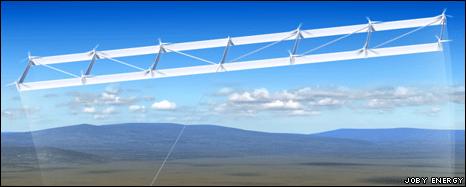Wind turbines take to the skies
- Published

For JoeBen Bevirt, the future of energy production is up in the clouds.
The inventor is currently putting the final touches to a series of large kites, which he says will be able to harvest the fast crosswinds found at high altitude.
His airborne wind turbines will take off and fly to around 2000 feet (600m), where they will float, generating power that can be transferred to the ground via a tether.
"Global wind is a tremendous source of energy - carrying nearly 870 terrawatts in global tropospheric winds," says Mr Bevirt of Joby Energy, which is developing the wind turbine technology.
"In comparison, the global demand is 17 terawatts. Harnessing a tiny fraction will transform the way we power our civilization."
Aiming high
The notion of tapping into high altitude winds was first posed in the 1970s, but was not technically possible.
However, recent advances in materials, computing resources and unmanned aerial vehicles have now made the idea viable.
As a result, a handful of companies are now exploring different designs to generate cheap renewable energy from the skies.
For example, Magenn Power's Air Rotor System called (MARS) uses a helium filled blimp design, Sky WindPower is building flying electric generators and Kitegen is focused on creating power kites.
Joby Energy's technology resembles a large multi-winged kite.
The autonomous structures are computer-controlled and can take off vertically before navigating to the desired altitude.
Flight is controlled by an advanced computer system and the harnessed electricity is sent down the tether to a substation where it is converted from DC to AC power which can then be routed to a power grid.
The technology's inventors say the devices are portable and relatively inexpensive to build when compared to conventional wind turbines and can generate twice the amount of power.
"Operating at five times the height of a conventional turbine increases both wind speed and consistency resulting in more power, more often," said Mr Bevirt.
And going even higher should, in theory, produce even more power.
"Going higher increases the velocity of wind that is available," says Professor William Moomaw, director at the Center for International Environment and Resource Policy at Tufts University in Massachusetts.
"The higher speeds at the greater altitudes should produce significantly more electricity."
The technology can potentially navigate to altitudes of 35,000 feet (10,600m), but the company has had to restrict their flying altitudes to 2000 feet or less due to concerns expressed by the US Federal Aviation Administration.
Air safety
After testing more than 20 different prototypes, the company has settled on a 30kW system, which it is using to evaluate the efficiency of the design. If successful, it intends to pilot test a 100kW prototype within the next year.
The firm's goal is to create an initial line of systems with a power capacity of 300kW which would be capable of generating enough energy to power around 150 homes. Larger systems of 3MW or more could potentially power 1500 homes.
Eventually wind farms containing several airborne wind energy turbines could be constructed to deliver power consistently, the firm says.
However, there are several issues to be addressed.
"They need to demonstrate that the energy cost is not too great to negate the benefits," said Professor Moomaw.
In addition, the firm must demonstrate reliable control systems and show that the entire system is safe.
"The tether wire, drooping diagonally to the ground, represents a larger ground area for which there is a hazard than that made by a normal turbine," says Professor Mick Womersely, director of sustainability at Unity College, Maine.
Mr Bevirt says that the systems are engineered to be strong enough to operate in very strong winds and if the turbines ever encounter gale-force type winds, the system would land itself and be re-deployed when conditions improved.
"We've also engineered our systems with multiple safety attributes. If one motor fails, the system can continue operation because of its multiple-motor design," says Mr Bevirt.
"If the tether is severed, the system can be landed safely, powered by onboard batteries.
"From an electrical hazard perspective, the power also automatically shuts down should the tether be severed leaving it non-energised when it touches ground"
The firm initially plans to deploy the technology in thinly populated areas with strong winds to road-test the technology thoroughly.
If successful, Mr Bevirt hopes to deploy his technology around the world.
"Our goal is to deploy airborne wind turbines globally to produce cheap, consistent, and abundant electricity for a prosperous planet."
- Published8 January 2010
- Published20 October 2008
- Published15 August 2008
- Published9 December 2009
- Published2 May 2007